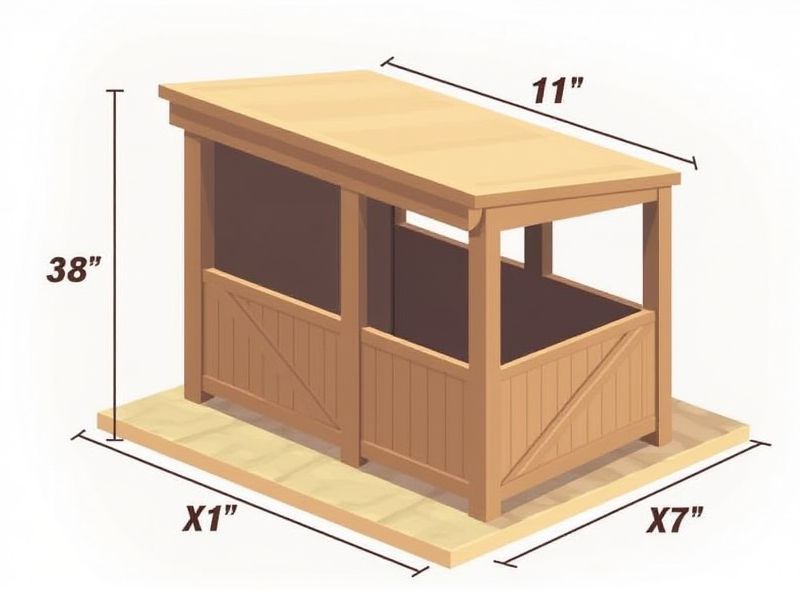
When planning a horse stall, knowing standard dimensions ensures safety and comfort for your horse. Most commonly, stalls are 12 feet by 12 feet, which provides ample space for an average-sized horse to move and lie down comfortably. For larger breeds, some owners choose 12 feet by 14 feet to allow even more room. Ensuring proper sizing helps reduce stress and the risk of injury for your horse, making their daily environment much more enjoyable.
Minimum Stall Size
The minimum stall size for a horse is typically 10 feet by 10 feet for smaller breeds and 12 feet by 12 feet for larger breeds, ensuring adequate space for movement and comfort. Proper ventilation and drainage should be incorporated into stall design, promoting a healthy environment to reduce respiratory issues and other health problems. Additionally, a minimum height of 8 feet is recommended for stalls to prevent horses from feeling confined or stressed. Regular maintenance of the stall, including bedding changes and cleanliness, is essential for the well-being of your horse.
Ceiling Height
A standard horse stall typically requires a minimum ceiling height of 8 to 10 feet, ensuring adequate space for horses to move comfortably. This height accommodates various breeds, including taller ones like Warmbloods that can stand over 16 hands. A well-designed stall with sufficient ceiling height promotes better ventilation, reducing the risk of respiratory issues. For your horse's safety and well-being, consider installing overhead fixtures at least 12 inches above the stall height to prevent accidents.
Door Width
The standard door width for a horse stall typically ranges from 4 to 6 feet, allowing for easy entry and exit of the horse. A width of 4 feet is often sufficient for smaller breeds, while larger breeds may require a minimum of 5 to 6 feet to ensure comfort and safety. Proper door width is crucial in preventing injuries during the stall opening process and facilitating efficient stall cleaning. Consider your horse's size and behavior when determining the ideal door width for your stall design.
Door Height
The standard door height for horse stalls typically ranges from 7 to 8 feet, accommodating various horse breeds and their unique height requirements. A door height of 7 feet is generally suitable for most horses, while larger breeds may benefit from 8-foot doors to ensure safe exiting and entering. Proper door height not only promotes ease of access but also enhances ventilation, an essential aspect of horse health and comfort. Ensuring your stall door meets these height standards can significantly improve your horse's overall well-being and stability within its environment.
Flooring Type
Choosing the right flooring type for your horse stall is crucial for maintaining a safe and comfortable environment. Popular options include rubber mats, dirt, straw, and wood shavings, each providing unique benefits such as shock absorption and drainage. Rubber mats, for instance, offer durability and ease of cleaning, while straw and wood shavings promote natural insulation and comfort. A well-maintained stall floor can reduce the likelihood of injury, supporting the health and well-being of your horse over time.
Ventilation Requirements
Proper ventilation in a horse stall is crucial for maintaining a healthy environment, which requires a minimum of 4-6 air changes per hour. The stall should have windows or vents placed at least 10-12 feet above the ground to ensure adequate airflow while preventing drafts that can stress horses. Ideally, you should consider natural ventilation methods, like cross-ventilation from openings on opposite sides, as well as mechanical systems if necessary, especially in barns housing multiple stalls. Ensuring that your stall maintains a consistent temperature and low humidity level is essential, with humidity levels ideally between 50% and 70% to prevent respiratory issues.
Wall Height
The ideal wall height for a horse stall ranges between 8 to 12 feet, ensuring the animal's safety and comfort. A height of 10 feet is often preferred as it provides ample ventilation while preventing the horse from attempting to escape. If your stall must accommodate larger breeds like Draft horses, consider walls on the taller end of this spectrum. Proper wall height also contributes to reducing stress in horses, as they can observe their environment without feeling confined.
Feeding Space
In a standard horse stall, the recommended feeding space is typically 3 to 4 feet wide, allowing horses ample room to eat comfortably without feeling confined. This dimension helps minimize stress and promotes natural grazing behavior, ensuring your horse can eat in a relaxed position. It's essential to provide a clean feeding area, maintaining a height of 24 to 30 inches from the ground to prevent waste and contamination. Proper feeding space not only enhances your horse's well-being but also aids in digestion and overall health.
Water Access
Access to clean water is crucial for maintaining horse health and hydration in a standard horse stall. It's recommended that each stall should include a water source, ideally a reliable automatic waterer, to ensure your horse has constant access to fresh water. Studies show that horses require approximately 5 to 10 gallons of water daily, depending on factors such as workload and weather conditions. Regularly check and clean water sources to prevent contamination, providing your horse with optimal care.
Lighting Needs
Proper lighting in a horse stall is essential for both the well-being of the horse and the efficiency of daily activities. Ideally, each stall should be equipped with at least 200-300 lumens per square foot to ensure sufficient visibility. Natural light sources, such as windows or skylights, can provide beneficial illumination, promoting your horse's natural circadian rhythms. Remember that LED lights not only reduce energy consumption by up to 75%, but they also can last for up to 25,000 hours, making them a cost-effective choice for your barn's lighting needs.
